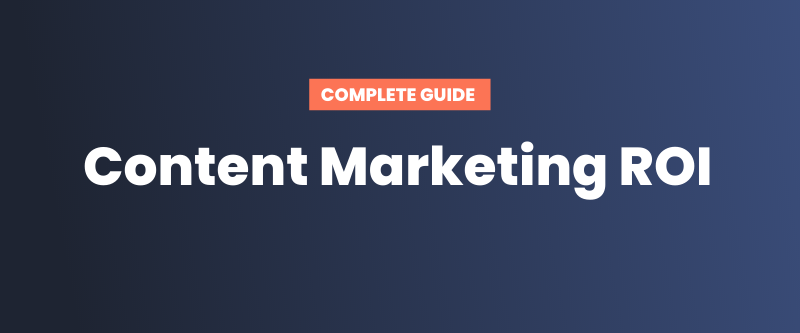Most business owners want to know what they can expect from their marketing efforts. But when it comes to content, results can be tough to measure.
Part of the problem is, it’s not just money spent. Content marketing is crazy labor-intensive and it can be difficult to figure out the ROI on time. Even the pros have trouble doing it.
And while not understanding your ROI doesn’t mean that your content won’t be effective, it does mean that you’ll never know exactly how effective it is.
There are a lot of people out there who try to explain exactly how to measure your content marketing ROI. Many of them fall short. That’s why we’ve put together this guide to make it as easy as possible to understand (even the high-level stuff!).
If you’re ready to start measuring the results of your marketing efforts, this is the post for you.
Let’s start with the basics:
What is Content Marketing ROI?
First, it might be helpful to talk about what content marketing is. If you’re reading this, you’re probably already aware, but just in case: content marketing is simply the act of creating and sharing online materials.
It could be videos, blogs, infographics, email newsletters–literally anything that you can create and publish online.
The goal of content marketing is to create a connection with your audience–to be seen as a valuable resource, rather than just a sales machine. And it works! Content marketing is proven to boost traffic, turn that traffic into leads, and turn those leads into sales.
And those leads and that increased traffic? That’s your ROI. In it’s simplest form, it looks like this: ROI = return on investment.
For those that are not mathematically inclined, that means that your ROI is equal to your return divided by your investments.
Of course, it’s not that easy. If it was, we wouldn’t have to write this article. Like everything in marketing, there are lots of factors that can go into both your investment and return. Some (like time spent) are not that easy to assign a value to.
Generally speaking, this is what each side might include:
Investment
- Cost of producing content
- Cost of hiring external help (freelance writers, brand strategists, etc.)
- Time spent planning and managing a content creation strategy
- Content distribution
- Advertising costs
- Software and tools used for content creation
Return
- Leads and conversions
- Improved SEO
- Increased traffic
- Brand awareness/brand image
If you know how to quantify those elements in terms of potential for sales, you can easily determine ROI. We’ll get into that in a bit.
Why is Content Marketing ROI Important To Measure?
Everyone knows content marketing is amazing. A 2012 whitepaper from Kapost showed that, on average, content marketing produces three times more leads for large companies when compared with other forms of marketing. Six years down the road, those numbers are still holding steady.
So why would you need to measure ROI? If you know that it’s working, do you really need to know the exact numbers? In a nutshell: yes!
If you’ve set SMART goals, measuring ROI can tell you if (and how) you’re meeting them. In turn, that can help you:
- Build a case for content marketing
- Get leadership to buy into your strategy
- Get your marketing plans approved
- Earn more conversions and sales!
Getting the C-suite, or even just your business partner, to sign off on a complicated marketing strategy can be difficult–especially if they don’t understand what you’re talking about. But the one thing everyone does understand is money. Proving a generous ROI can help you sell your case.
The Challenges With Measuring Content Marketing ROI
When it comes to ROI, the formula is the easy part (that’s the ROI = return/investment thing we went over above). The problem is, ROI isn’t always quantitative–and it’s hard to do a mathematical formula without any numbers.
In fact, more often than not, ROI is qualitative, meaning it has a value other than dollars earned. Some examples of that would be increased customer advocacy or recognition as a thought leader.
Beyond that, the dark web can throw a massive wrench in the gears. ROI can be hard to measure even when you have all the numbers–and when certain members of your audience are hiding all of their movements and you literally can’t track anything they do, well. It’s near impossible.
It’s been called “the place where data goes to die”.
So what can you do? In both scenarios, it can help to think of your ROI in terms of quality rather than quantity:
- Am I giving my clients the content they need?
- Am I providing relevant (and useful) information?
- Am I developing solid relationships?
This is a harder sell to higher-ups, for sure. But just remind them: 79% of consumers say that a brand has to demonstrate that they know and care about them before they’ll consider doing business. And what better way to demonstrate caring than quality content??
What Elements Should You Measure In Your Content Marketing ROI?
As we’ve said, content marketing metrics can be hard to track. But that doesn’t mean it’s impossible. Here’s what you can look at:
- Consumption: These are basic metrics that let you know how many people have viewed or accessed your content. Using Google Analytics, you can quickly and easily view lots of data such as:
- Users (the total number of unique visitors to your page)
- Time on page
- Downloads
- Clickthroughs
- Engagement: It’s great to know how many people visit your page, but engagement numbers give you a better idea of how they interact with your page. Here’s what you can get from Analytics:
- Average time on page
- Pages/session (the total number of pages a visitor looks at in a given session)
- New vs. Returning (the number of new visitors versus the number of returning)
- Referral traffic (an overview of other sites that are sending visitors your way)
- Retention: This gives you a good idea of how engaged your audience is. While some of these metrics may come from Google, some you may have to look up on your own (or use a different analytics program):
- Bounce rate
- Blog subscribers
- Number of followers on social networks
- Newsletter open rate and clickthroughs
- Conversion: These metrics are often the most important for your investors or C-suite. They prove the monetary value of your content marketing plan. Here’s what you should look up:
- Lead generation: goal completions and goal conversion rate
- Sales: transactions, time to purchase and assisted conversions
- Gated content (lead capture forms)
- Social media conversion tracking
- Blog and newsletter subscriptions
How To Measure Your Content Marketing ROI
Now that you understand a little about how ROI works and why you need to measure it, it’s time to get down to the nitty-gritty.
- Setting a budget: This is the portion of your budget, of course, which is dedicated to the creation and distribution of content. Setting a spending limit helps ensure that you’re able to properly track your ROI when the time comes. Costs may include extra staff, graphic design, and advertising. When setting your budget, you should consider the size of your company, goals, current staffing, and industry (especially look at what competitors are doing, because you don’t want to fall short in comparison).
- Understand your resources: Part of setting a realistic budget is understanding your current resources. Do you already have people on board who can write, edit, create videos, or design graphics? How about tech support and analysts? Some companies have to take on extra fulltime help to fill these roles, while others choose to outsource–and the costs can quickly add up.
- Outsourcing work: If you don’t have staff that are qualified to take on content creation, outsourcing can help ensure that you put out quality, professional looking material. Often, that means hiring a freelancer–but it could also mean employing a content marketing company or even finding a guest blogger.
- Set goals: A big part of a content marketing strategy is goals (and having measurable ones will make measuring ROI much easier). Here are some common objectives:
- Drive traffic and generate engagement
- Create brand awareness
- Generate prospects and sales
- Build audience loyalty
Now the fun part–measuring your success! Here’s how to do it:
1) Measure Your Investment
Figuring out exactly what you’ve put into your content marketing efforts might be easy, and it might not. If you’re paying a content marketing firm, a freelance copywriter, or a branding expert, those numbers are pretty simple to keep track of. However, if you’re using your current employees or even doing the work yourself, it gets a little murkier. In that case, you’d want to have the employees keep track of their time spent on content marketing duties, and then multiply that by their hourly rate of pay. For example, if an employee that makes $25/hour spends 50 hours on copywriting, the total investment would be $1,250.
2) Calculate Return
This is where things can get tricky. Sometimes, there is a clear link between content marketing and ROI (like when you send out an email newsletter, someone clicks on a link, and purchases a product). Sometimes, the relationship isn’t as obvious (like when someone has been following you on social media for months and at some point decides to sign up for a service).
Using the metrics we discussed above, you can easily determine a figure for actual sales made (this is the figure you’ll use in the formula). But you can also determine lead quality, traffic generated, and onsite engagement: all things that may lead to future sales.
3) Determine Your ROI
This all just boils down to the formula we shared with you earlier: ROI = return/investment. Simply take the sales revenue generated by content and divide it by the amount you spend on content marketing.
While all of those other metrics are important (especially when trying to predict future sales), it’s the money in the bank that really matters.
Why It’s Important To Use A Content Marketing ROI Tool
Most of these metrics can be tracked in Google Analytics, though marketing automation software and social analytics tools can give you further insight. Email and social media are especially important to track and Analytics doesn’t provide a ton of information on either.
We recently wrote an article on the 11 best tools for measuring content marketing ROI, but our absolute favorite is BuzzSumo. Here’s why:
Buzzsumo analyzes what content performs the best for any topic or competitor online and allows you to search, filter, and report on all of it. You can use it to quickly put in a search term or website URL and discover the top content around it along with inspiration for related terms, influencers, or websites. Plus, it makes it easy to monitor your brand, track engagement and reach, and find out what’s trending.
It comes at a cost, as do most of the higher-quality analytics tools, but it’s so worth it. The ability to do everything from one platform–from finding new blog ideas to using real-time analytics–is a huge time saver.
What Type of Content Marketing ROI Should I Expect?
When it comes to ROI, content marketing is the clear winner. You just can’t get a comparable ROI from anything else.
Why? It’s fairly low-cost (especially if you do it yourself) and it converts really well. 70% of consumers say that they’d rather learn about a brand through content than anywhere else (so it can be assumed that only 30% of consumers are really into looking at your paid ads, right?).
Need more numbers? 81% of marketers found that increased traffic occurs with as little as six hours a week invested in content marketing and 9 out of 10 consumers say that online content plays a role in their purchasing decisions.
Most importantly, after reading recommendations on a blog, 61% of U.S. online consumers made a purchase. That’s huge.
And that’s really not the end of it. If you do a quick Google search on “content marketing ROI”, you’ll find all sorts of numbers that prove its worth. A
While we can’t tell you exactly what rate of return to expect, we can tell you that it’ll be bigger than anything you’ve done before.
Bottom line?
We all care about the bottom line. And a happy audience means a better bottom line.
Content marketing makes it easier to attract, engage with, nurture, and convert leads. And when we know who is seeing our content and how they’re interacting with it, we can better determine our overall content marketing ROI.
Do you use content marketing in your business? Have you tried tracking your ROI? We’d love to hear your success stories!
If you have any comments or questions, leave them below and we’ll answer them in updates to the article.






